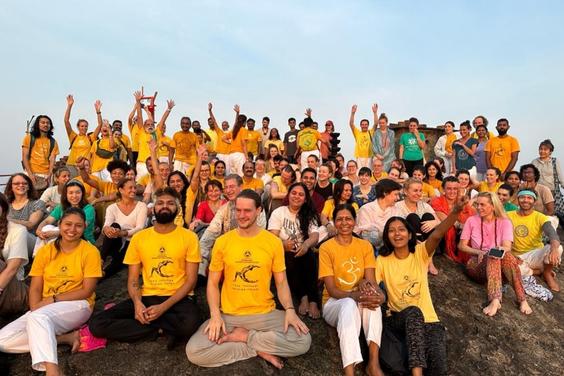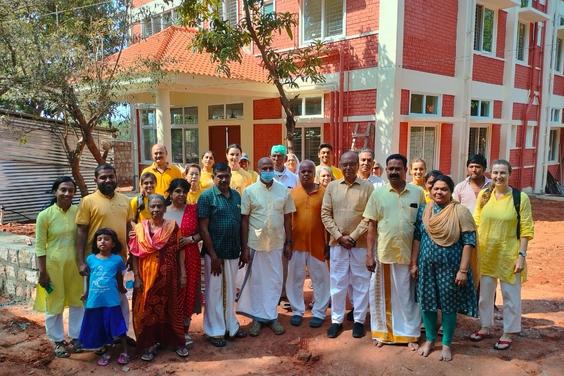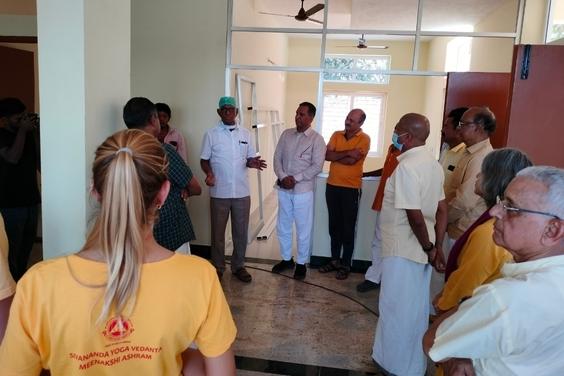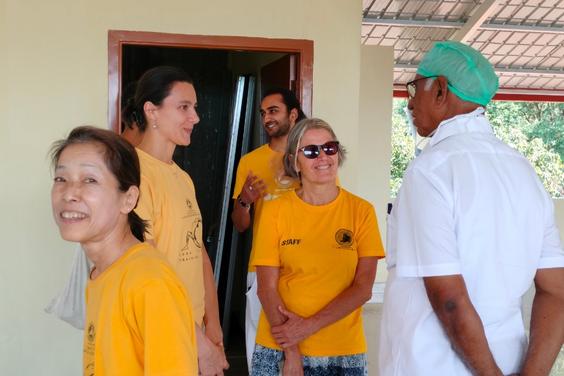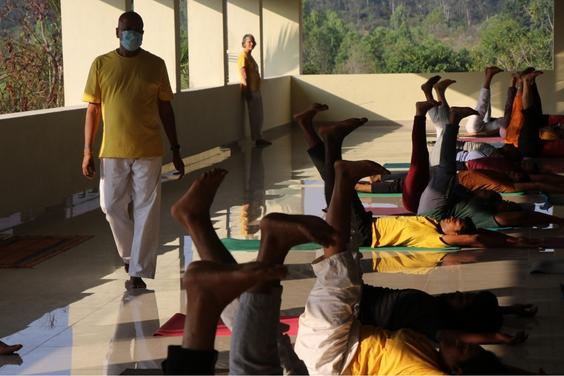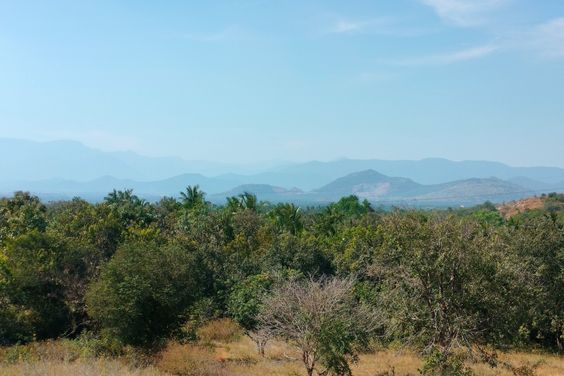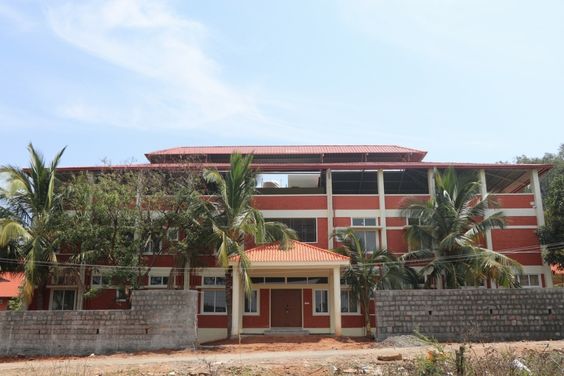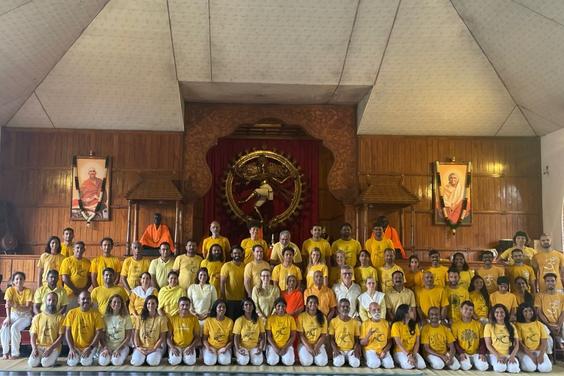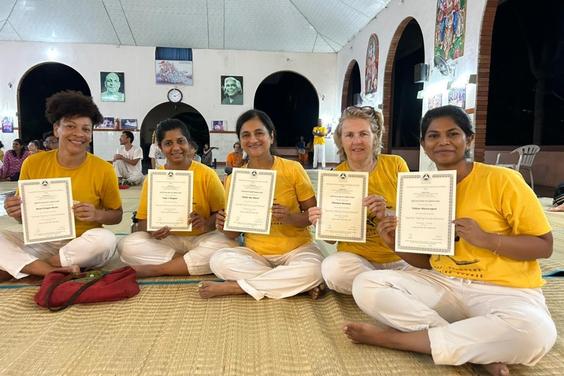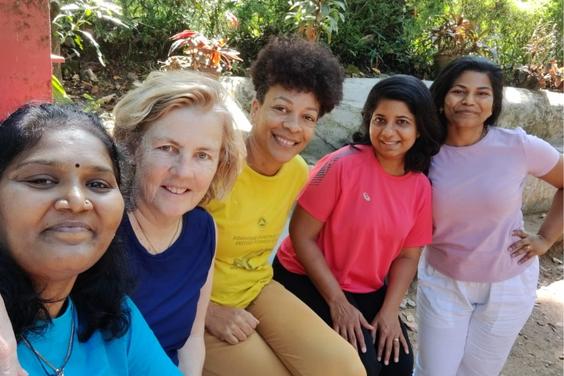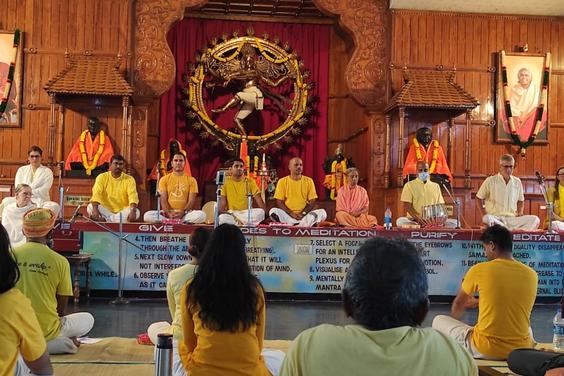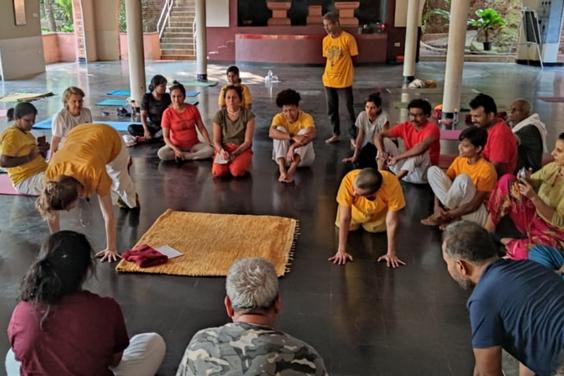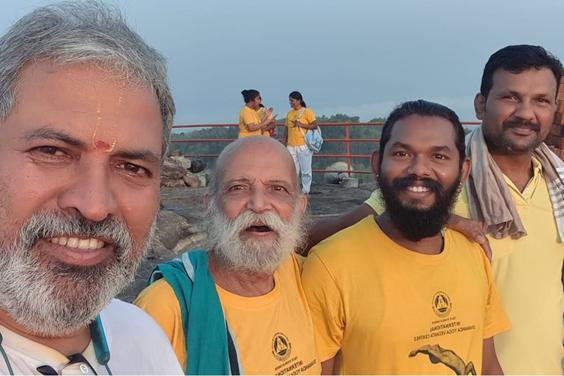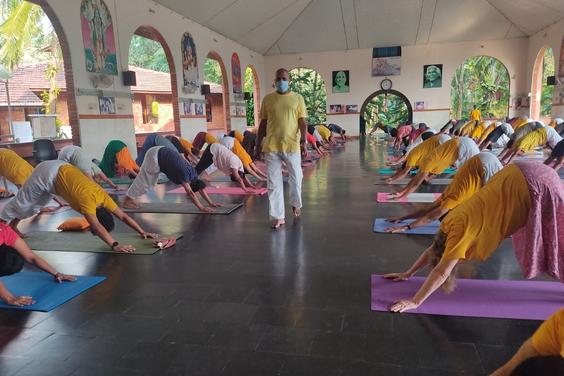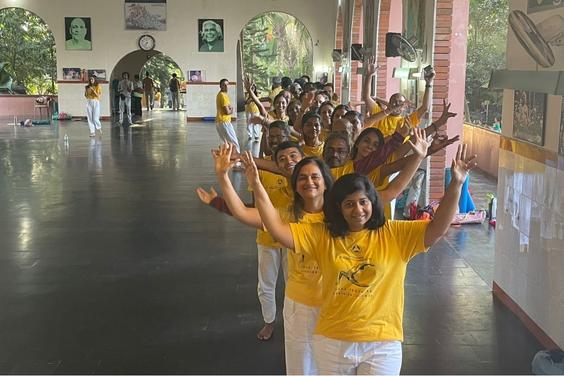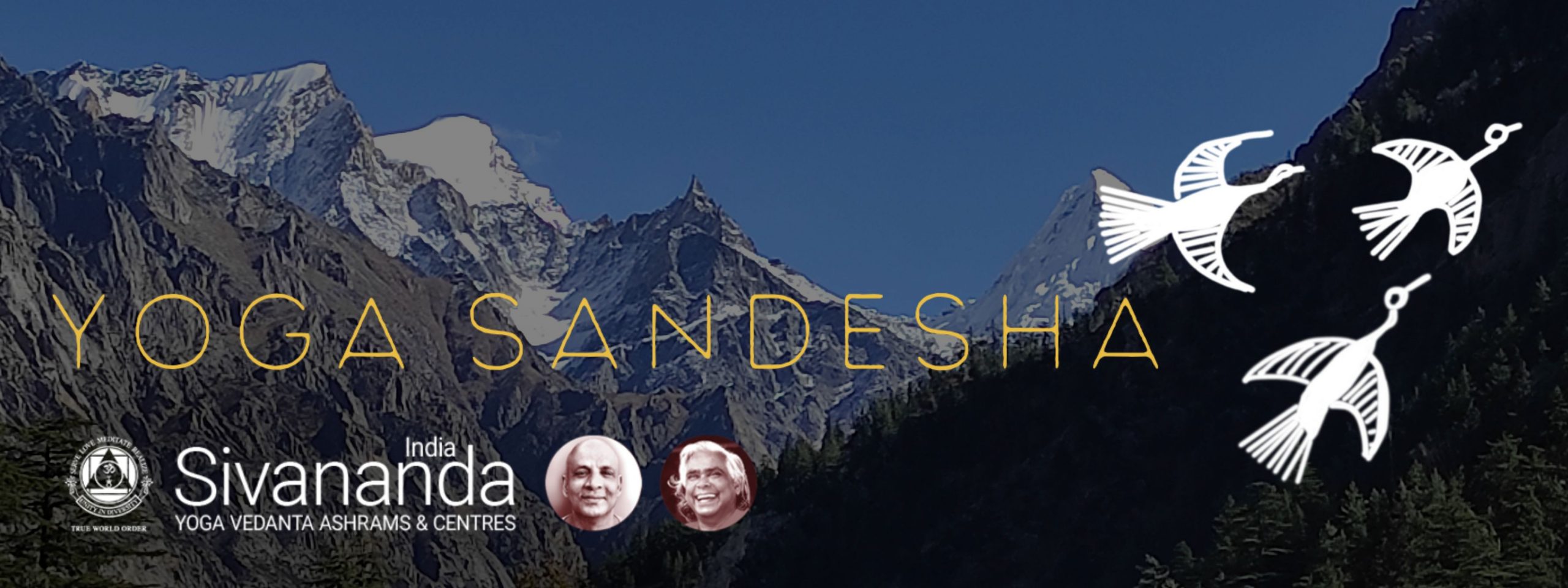
March 2023 | Community
Om Namah Sivaya
Blessed Self,
Throughout his life, Swami Vishnudevanandaji taught us to think not too much about ourselves, rather to think about others as well our communities. The peace missions he conducted in various countries were intended to bring conflicting communities together, whether to create open dialogue or greater harmony. For that he used the ancient teachings of yoga as a strong weapon. Swamiji believed that once a person is able to find peace and happiness within themselves, then they will be able to spread that to their community. The way to find that peace was through the practice of yoga.
More than ever, since the pandemic, we see many people flocking to the yoga practices, both in our Indian centres and ashrams. Our staff are working hard to pass on the teachings from Master and Swamiji to the visiting students and guests. Recently, we held our first Teachers’ Refresher Course at the Neyyar Dam Ashram. Enthusiastic teachers from around the globe gathered to share their experience of practising and teaching over many years and to take back some energy and inspiration from the teachings and from India. These are most encouraging signs and serve to further motivate us to practice and to keep our locations conducive for dedicated spiritual practices. In that spirit let us all practice and find the peace and happiness within that can spread to our communities around us, honouring Swamiji’s teachings of United We Live, Divided we Perish.
Pranams to all,
Sivananda Yoga Vedanta Ashrams & Centres, India
Living in community provides the best opportunities for us to learn, grow, and to apply the teachings in a practical sense. When we live alone we can generally have things just as we like them and we are not often required to adapt, adjust, accommodate. Within a community, each small interaction provides a chance to consider others, alongside our own needs. What is my own comfort and happiness if it is not also experienced by others?
It is interesting to read how Swami Sivananda handled everyday situations in the ashram. There are a couple of books that give such accounts written by disciples who were with him at the ashram in Rishikesh. One such account is From Man to God-Man: The Inspiring Life-Story of Sri Swami Sivananda, published by the Divine Life Society in South Africa. You will find an excerpt from that book in this newsletter. Such accounts often lend a fresh perspective on the teachings and how they were applied by our teachers within the community.
We hope you enjoy the newsletter. As usual, please feel free to reach out to us with your thoughts and feedback: [email protected]
News Item:
Trustees, Directors & ATTC Tour
of Sivananda Free Rural Medical Hospital
During our recent ATTC at Madurai Ashram and meeting of the Trustees and Directors of the Sivananda Yoga Vedanta Ashrams & Centres, India, we took the opportunity to tour the Sivananda Free Rural Medical Hospital, nearing completion. We got a chance to understand what services will be available to patients, including specialist care and operating theatre. The ATTC students also had a class on the terrace hall with spectacular views of the surrounding countryside. We look forward to opening the hospital soon and providing free medical care to the local village communities.
Photo Update:
First Teachers’ Training Course Refresher in India
From Feb 20 to 26, we welcomed 47 enthusiastic TTC graduates from around the world to connect and inspire one-another (and us!) at Neyyar Dam Ashram. The programme included early morning pranayama, special hatha yoga classes, workshops on teaching techniques, Vedanta, Raja Yoga, Sanskrit, and creative writing. Please enjoy these photos. Hope that you will join us next year to reconnect!
Upcoming Courses:
Learn, Practise & Grow with Us!
Teachers’ Training Course (TTC)
Mar 19 to Apr 15, Neyyar Dam, Kerala
Apr 9 to May 6, Netala, Himalayas
May 14 to June 10, Netala, Himalayas
For more details, click here
First ever Teachers’ Training Course (TTC) in Baddi, Himachal Pradesh
Apr 16 to May 13, 2023
For more details, click here
Sivananda Teachers’ Immersion Course (STIC)
May 12, 2023 to May 11, 2024
For more details, click here
Retreats
Tattva Bodha Retreat
Mar 13 to 19, Neyyar Dam, Kerala
Introduction to Vedanta Retreat
Apr 17 to 23, Neyyar Dam, Kerala
For more details, click here
Teachings Excerpt:
From Man to God-Man: The Inspiring Life-Story of Sri Swami Sivananda
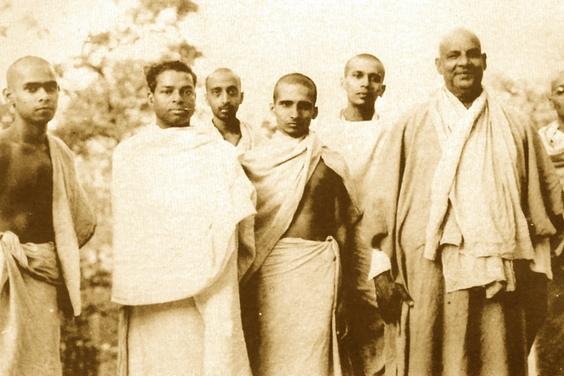
On January 15, 1956, some of the Ashram inmates were discussing with the Master the exorbitant charges that an outside presss had billed for printing a small book. It was the general feeling that the press had cheated the Society. Like a flash of lightning came the Master’s remark, “Well, think that you yourself are enjoying the money through those who have cheated you, who are none but your own Self. This is the key to peace and happiness.”
The Master’s strange reaction was not born of any fear complex. When in 1935 the possibility of some litigation with reference to the publication work of the Ashram was being discussed, he wrote to a disciple: “One should have every experience. Then only will fear and the feeling of shame disappear.”
Once again in 1955, when the Ashram authorities were hesitating to file a charge of embezzlement against an inmate who had absconded, the Master told them clearly, “If that is the right thing to do, do it. I am not afraid to go to court. We should welcome dishonour as well as honour.”
The absconding inmate was not the only instance of a wayward disciple. There were others. People erred, made some mistakes. Sometimes students disobeyed even their loving Master, mistaking his meekness for weakness. He usually gave them a long rope and would say, “Never mind. These are small blunders. Who has become great without committing mistakes? They are to be rectified gradually.” The Master believed in evolution.
There was in the Ashram at one time a young man of violent behaviour, who disposed of Ashram property for his personal gain, but the Master insisted on keeping him in the institution, saying, “I must serve him and reform him. Let him be here.”
From the very beginning the Master took the greatest delight in serving the bad characters. In one of his earliest letters written in the thirties to a disciple in Madras, he said, “I want around me any number of people who will abuse me, vilify me, insult me, and even injure me. I want to serve them, educate them, elevate them, and transform them.”
“Hate the sin but not the sinner,” advised the Master.
Research/Links
- A study about emotional and mental wellbeing and yoga called, “Hippocampus: Promoting Mental Health and Wellbeing among Young People through Yoga” was performed on the young people in Norway to realize the effect of Yoga on participants emotional health. Read the interesting research here
https://www.ncbi.nlm.nih.gov/pmc/articles/PMC8645589/
Spiritual Calendar
March 2 – Ekadasi
March 7 – Full Moon
March 8 – Holi
March 18 – Ekadasi
March 21 – New Moon
March 30 – Ramanavami
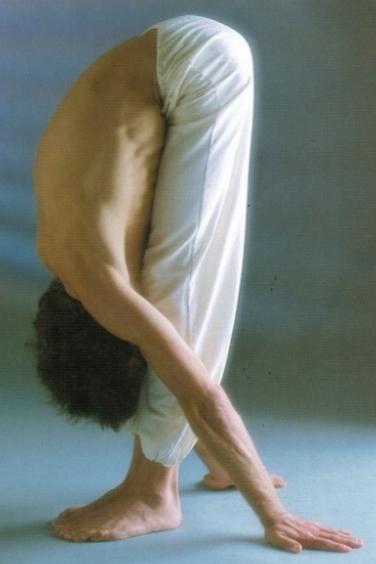
Teaching Tips:
Ayurvedic Yoga Approach for Anxiety
Anxiety in Ayurveda is seen as an energetic imbalance of the nervous system. It is understood to be caused by the imbalance of Vata dosha causing pranic vibrations in the nervous system that manifest as anxiety at the body-mind level. Thus, in Ayurvedic terminology, anxiety is understood as subtle tremors of the nervous system due to erratic flow of air currents in the body, an attribute of a high vata state. The prime seat of vata is in the colon and bones, thus most bone-related conditions are seen as a manifestaion of vata dosha.
Physically, vata’s generally have a thin body frame and a high nervous energy flow manifesting in body-mind symptoms like dryness, arthritic conditions, insomnia, mood swings, and anxiety. From the perspective of yoga practice, bringing in the opposite qualities helps balance vata personality types. Since being impulsive, anxious, and erractic is the natural manifestaion of high vata condition, using grounding, gentle, warming, and stabalizing practices creates balance and harmony.
Asanas for Vata: Since the seat of vata is the lower abdomen, colon, large intestine, and pelvis, working on these areas helps balance vata energy. Also, at the mind level, disturbed vata shows up as anxiety due to its turbulent effect on the nervous system. Thus, the yoga practices for vata dosha must be gentle to calm down the erratic flow of vata energy, while also strengthening the areas which are the seat of vata.
These following asanas work on the body-mind level to release the physical manifestations of anxiety and target the root area where anxiety builds up:
- Pada Hastasana (Standing Forward Bend) – Releases the strain caused in lower back as a manifestaion of dryness and brittleness building up.
- Paschimottanasana (Sitting Forward Bend) – Targets the lower abdomen, the seat of vata to release excess gas (vata) & strengthen lower abdominal organs.
- Sasankasana (Child’s pose) – Creates compression in the pelvis which is the seat of vata. At the physical level it helps deal with the manifestation of vata in the pelvis that shows up as menstrual concerns, chronic gas, and constipation.
- Dhanurasana (Bow)– Stretches the lower back while stimulating the pelvic region providing relief in vata aggravated conditions.
- Pranayama – Builds nervous energy and regulates the pranic currents in the nervous system to provide relief from anxiety.
Book Review:
Radha – Diary of a Woman’s Search,
by Swami Sivananda Radha
As the name suggests, this book, written by Swami Sivananda Radha is a perfect eye opener for anyone walking the spiritual path in search of guidance and assurance. More so if you are a woman, this book will help you meander through your own doubts and confusions about your spiritual journey and guide you further in your quest. A perfect gift you can give yourself for Women’s Day!
The book journals the story of Sylvia Hellman and her transformation to Swami Sivananda Radha. From her experience of war-torn Germany in her earlier days and her knowledge of modern interpretive dance, Sylvia looks for deeper meaning and purpose as she lives the modern western life in Canada. Her vision of meeting Swami Sivananda of Rishikesh, urges her to take up the journey to India to meet him.
The story of Swami Radha exemplifies and gives various opportunities to the reader to question themselves on their own practice, discipline, dedication, and motivation. It takes only six months of sheer hard work at Rishikesh with Swami Sivananda to transform Swami Radha to what she is known for today. The book closely looks at the teacher disciple relationship and brings out the various nuances very aptly and succinctly. The story of Swami Radha unfolds all the challenges, insights, and spiritual training she needed to move ahead in her quest. This attempt by Swami Radha in sharing her personal story moves the reader to experience and understand the various emotions, feelings, and moments of truth through her lens.
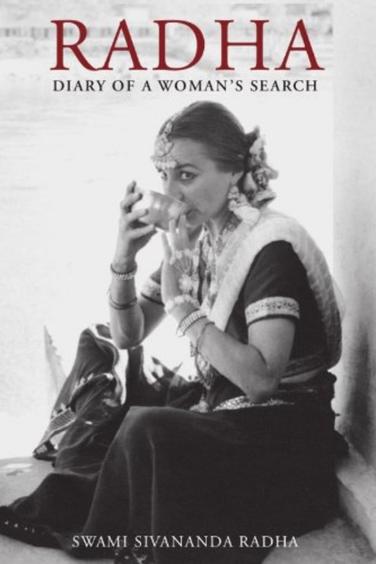
The book begins with Swami Radha’s initial qualms about all the basic Indian discomforts she faces as any foreigner would experience. From having sleepless nights due to the lizard on the wall, bed bugs in her room, to dealing with spicy food and traveling in the local trains and taxis, seeing the poverty and the beggars, she is deeply affected and this further fuels her spiritual quest. Although, in her mind she is very curious to meet Swami Sivananda, her first meeting is quite uneventful, and she feels a mental connection with him and gets the feeling of coming home.
After making her entry into the ashram the roller coaster ride of thoughts and emotions begin to overrule her days. All her hopes of finding her calling start to diminish. From attending satsangs and watching and learning from Swami Sivananda closely, Swami Radha slowly starts to come to terms with her own doubts and as any true seeker gets consistent with her own practice and stays devoted to her Guru.
We also come across the beautiful relationship between Swami Radha and other disciples who live in the ashram, who were there to always support her. Swami Venkatesananda, Swami Vishnudevanda, Swami Chidananda, and Swami Nadabrahmananda–Swami Radha had a friend and teacher in each of them. Many times, we find her in a state of delusion, confusion, and a lack of clear vision. Her questioning mind often would make her think of why she should suffer sitting cross legged for four hours in a satsang and deal with spicy food. Her courage in asking questions to Swami Sivananda on various aspects brings clarity to her mission and purpose. On one instance when she grabs her notebook to write down something, Swami Sivananda tells her to put it away and to learn to listen with heart and intuition. On another instance she is asked to address a gathering of hundreds of people and share her knowledge for which she prepares and comes with her sheet of notes. Swami praises her industriousness in planning but takes her notes and asks her to give the speech by saying let the divine flow through, just surrender. Although she gets nervous, this episode teaches her the meaning of surrender. Her learning on the law of karma comes through from Swami Venkatesanda who shares a beautiful story and then says that the law of karma applies as long as you think ‘you’ are the doer.
The book gives the readers many gems of wisdom from Swami Sivandanda through his teachings to Swami Radha. Her efforts as a sincere disciple comes through in her dedication to learn aspects of yoga, vedanta, music, dance, and mantra chanting. From learning lessons on gifting, to managing and overcoming anger and various other aspects, Swami Radha finally realizes that to build a cathedral of consciousness one needs an experienced architect and for her it was Swami Sivananda.
The book culminates with the initiation of Swami Radha into sannyas, and the beginning of her new role and journey to take the teachings of the Master to the western world as Swami Sivananda Radha. He tells her that purity of mind comes from selfless service and that will make one divine. He also assures her that if God gives you work, he will also give you the tools for it.
She further goes on to meet Babaji and learns to invoke the divine light, which leads to the expansion of her consciousness. In his farewell speech before she leaves for Canada, Swami Sivananda extolls the devotion and dedication of Swami Radha. He also clears the myth that yoga is not about flying in the air, walking on water, or performing miracles, but in being peaceful, calm, radiating joy and having a willing heart to serve everybody, and a constant desire to attain divinity.
I highly recommend this book and leave it to you, the reader, to discover the hidden gems it has to offer.
— Chitra Ganesh, Chennai
Recipe:
Khichdi – A Wonder Food for Yogis
Hardly an Indian household would be unaware of the miracle food Khichdi, and in yogic circles, khichdi is likely the most talked-about food.
Importance of Khichdi in Yoga and Ayurveda: The entire focus of yogis is to keep the energy levels up, work with the spine to be able to release energy, and keep the digestion light to support the energy needed during the practice. Further, during times of rest and relaxation, yogis crave for grounding, stability, and a state of inner balance.
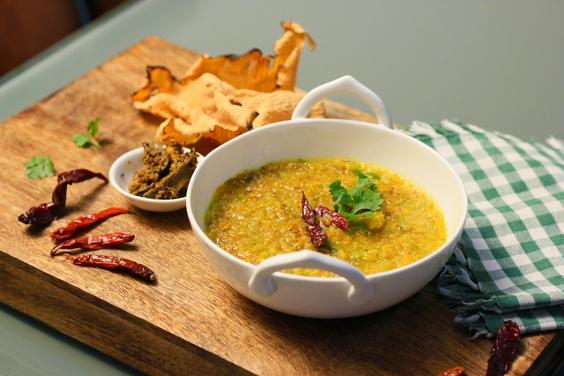
From an Ayurvedic perspective, khichdi is considered to be highly detoxifying. It resets the digestive system by giving it a rest from heavy foods. The simple ingredients used to make khichdi include yellow mung dal, rice, ghee, spices, and vegetables form a medley of super nutritious foods which are easy to digest, complete in nutrition, nourishing for the dhatus (fundamental principles supporting the structure and function of the body), fabulous in taste, and filling, to keep the cravings at bay. Also, khichdi is tridoshic, which means it is a perfect food for people with any kind of energetic imbalance in vata, pitta, and kapha tendencies.
Variations as Per Dosha Type: The most versatile part about khichdi is that it can be modified skilfully using various spices and vegetables to suit any dosha type. For vata dosha khichdi can be modified by adding extra ghee to control vata tendencies. A pinch of cayenne pepper or ginger can get the stuck vata flowing. Vegetables like carrots, pumpkin, zucchini, peas, sweet potatoes, and asparagus create a grounding effect for vata types. For pitta dosha khichdi can be modified by adding coconut oil. Vegetables like leafy greens, broccoli, and cauliflower support the heated condition of pitta types. For kapha dosha khichdi can be modified by omitting oil altogether and softening the spices in water. Rice can be replaced with quinoa, millet, and amaranth. In an imbalanced state, kaphas need a push to move and spices like ginger and cayenne pepper can help move the stagnant accumulations.
Science Behind the Efficacy of Khichdi: Khichdi is easy to digest and does not burden the digestive system which often takes about 70% of our energy. When the digestive system consumes that much energy, there is less left at our disposal to achieve other tasks. Khichdi has a cleansing effect on the digestive system, while also making proteins available to the body, and making one feel well satiated, even while cleansing.
Ingredients (serves 1)
- 1/2 cup brown rice
- 1 cup yellow mung dal
- 6 cups (approx.) water
- 1 inch grated ginger
- Mineral or sea salt to taste
- Ghee
- Spices like cumin, hing, coriander, and turmeric powder
- Vegetables of choice
- Cilantro for topping
Instructions
- Wash rice & yellow mung dal & add 6 cups of water.
- Cook for about 20 minutes.
- Add the vegetables and cook for another 10 minutes.
- Alongside, sauté the spices in ghee in a separate saucepan.
- Add to the cooked dal, rice, and vegetable mixture when ready & add the salt.
- Top-it with cilantro and serve. Enjoy!
“Do all the good that you can, in all the ways you can, to all people you can, at all times, with all zeal, strength and love.”
— Swami Sivananda

